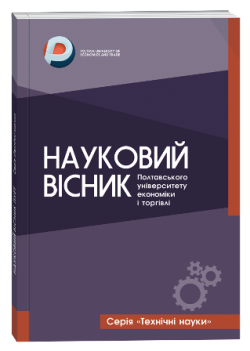ANALYSIS OF THE QUALITY INDICATORS OF NEW TYPES OF HALVAH USING THE DESCRIPTIVE ASSESSMENT METHOD
Abstract
The objects of the study were two new types of halva produced by Zhadana Plus LLC with an improved recipe composition: sunflower halva with cherry jam; sunflower halva with apricot jam. The subject of the study is the organoleptic and physicochemical indicators of the quality of halva with an improved composition. The aim was to investigate the nutritional properties of halva with the addition of cherry and apricot jam using standard research methods and a descriptive method. Classical methods of commodity science were used for the research. Organoleptic and physicochemical quality assessment was carried out in accordance with the national standard in the laboratories of the Poltava University of Economics and Trade. Organoleptically, taste, smell, color, consistency, presence of extraneous impurities were assessed in the proposed products. From the physical and chemical parameters, the mass fraction of moisture and total ash was determined. The mass fraction of moisture is 5.5% and 6.0% for sample 1 and sample 2, respectively. The mass fraction of ash is 1.8% and 1.7%, respectively. It was found that the addition of jams to the recipe had a positive effect on the nutritional balance of the product, and also improved the taste properties of halva. As a result of the study of the quality of halva with cherry and apricot jam, it can be concluded that such halva does not meet the requirements of regulatory documents in terms of such parameters as structure, consistency and moisture content. The regulatory document indicated on the packaging does not correspond to the name of the product. It is recommended that the manufacturing enterprise develop technical conditions for the products, for their compliance with regulatory documentation. Further research is planned to be devoted to the study of the quality and safety management system in the production of halva.
References
2. Зуєва, Ю.В. Дослідження та розробка процесу багатошарового формувань халви: автореферат/Ю.В. Зуєва. – М., 2008. – 146 с.
3. Калачев М.В. Снижаем калорийность халвы. / М.В. Калачев, Ю.В. Зуева // Кондитерское производство. – 2009. – № 2. – С. 24 – 25.
4. Balasundram, N. Phenolic compounds in plant and agri-industrial byproducts: antioxidant activity, occurrence, and potential uses / N. Balasundram, K. Sundram, S. Samman // Food Chemistry. 2006. – V. 99, № 1. – P. 191-203.
5. Халва. Загальні технічні вимоги : ДСТУ 4188:2003 / [Чинний від 2004-07-01]. – Київ : Держспоживстандарт, 2003. – 12 с. – (Національний стандарт України).
6. ДСТУ ISO 4121 : 2010 Дослідження сенсорне. Настанови щодо застосування шкал кількісних реакцій (ISO 4121:2003, IDT). – Чинний від 01.01.12. – К. : Держспоживстандарт, 2013. – 12 с. – (Національний стандарт України).


